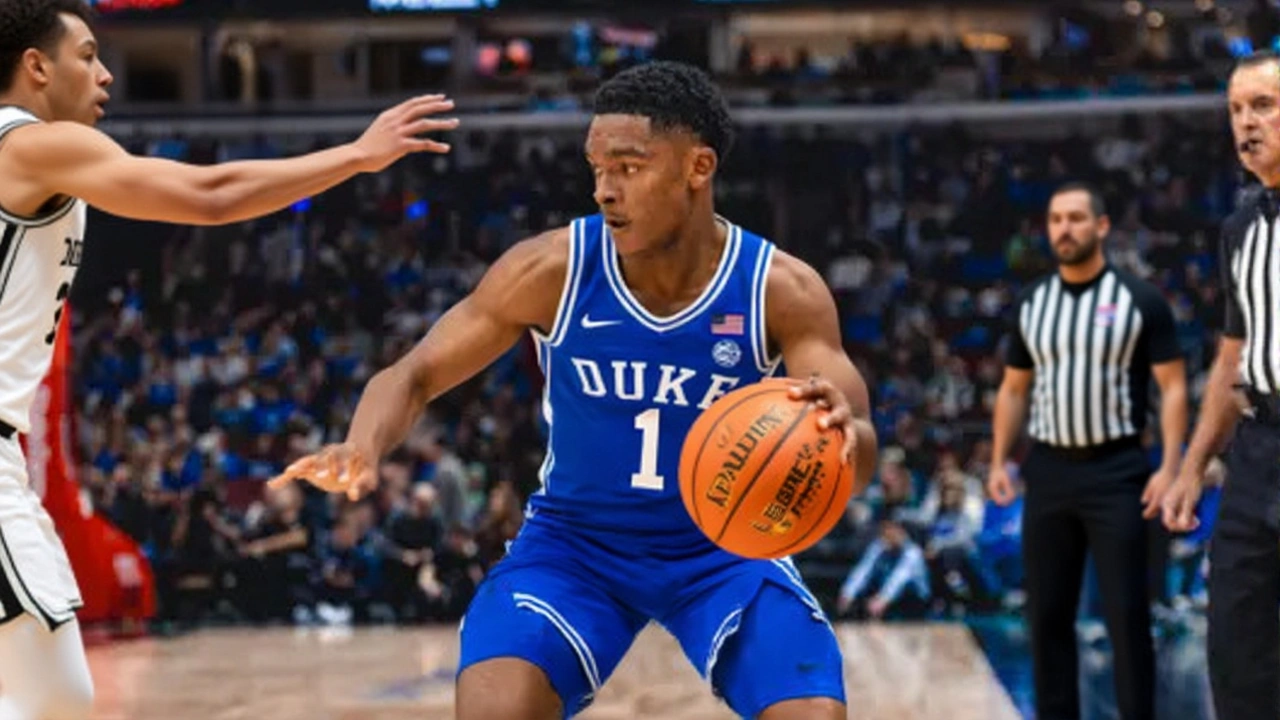When Cameron Boozer drove baseline for a thunderous two-handed slam with 4:12 left, the crowd at Madison Square Garden erupted—not just for the dunk, but for the statement: Duke Blue Devils aren’t just winning. They’re imposing their will. The freshman forward finished with 18 points on 13-for-16 shooting, leading Duke to a 78-66 victory over Kansas Jayhawks on Tuesday, November 18, 2025, in the State Farm Champions ClassicMadison Square Garden. It wasn’t pretty. It wasn’t clean. But it was gritty. And for a Duke team still finding its identity under first-year head coach Jon Scheyer, that’s exactly what they needed.
Resilience Over Flash
Duke led 41-37 at halftime, but Kansas didn’t fold. The Jayhawks, led by sophomore center Flory Bidunga, clawed back within five points three times in the second half. Each time, Duke answered—not with a three-pointer, but with a defensive stop. Coach Scheyer called it the defining difference: "Our defensive rebounding. That’s been an issue we’ve had to address. Our guys did that. Held them single-digit rebounds." The numbers backed him up: Kansas grabbed just eight offensive boards all night, compared to Duke’s 14. That’s not just good defense. That’s psychological dominance.
And then there were the turnovers. Two. In the entire second half. After committing 11 in the first 20 minutes, Duke tightened like a vault. Guard Caleb Foster, an 18-year-old freshman from Houston, put it simply: "It’s what dreams are made of. It’s what you come to Duke for." And for a program that’s won five national titles but has struggled to replicate its past dominance since Mike Krzyzewski’s retirement, this kind of poise under pressure matters more than stats.
The Kansas Contrast
Just two days earlier, Flory Bidunga had torched Princeton for 25 points on 10-of-11 shooting. Against Duke? He finished with 12 points and six rebounds, largely contained by the physical presence of Dame Sarr and Patrick Ngongba II. The Jayhawks’ offense, which had been fluid and efficient, looked disjointed. They shot just 38% from the field and were outscored 18-4 in second-chance points. "They didn’t let us breathe," said Kansas coach Bill Self in his post-game remarks. "We got what we wanted early, but they made us work for everything after halftime. That’s the difference between a good team and a great one."
That’s the reality Kansas now faces. After a 3-1 start that included a win over then-No. 11 North Carolina, the Jayhawks’ schedule has turned brutal. Three neutral-site games in eight days—this one against Duke, then Notre Dame on November 25, then Syracuse on November 29. No home court. No rest. No margin for error.
The Bigger Picture
Duke’s win isn’t just a signature non-conference victory. It’s a signal. The Blue Devils are 5-0 for the first time since 2020. They’ve beaten Army by 31, Indiana State by 34, and now a ranked Kansas team on a neutral floor. And they’ve done it without their star freshman guard, who’s still recovering from a minor ankle sprain. Boozer’s efficiency—81% shooting—isn’t sustainable. But the team’s discipline is. Duke’s turnover rate dropped from 14.6 per game to just 7.5 in their last three contests. That’s not luck. That’s coaching.
Meanwhile, State Farm Champions Classic, now in its 15th year, continues to deliver. The event, sponsored by State Farm Insurance Companies, drew an estimated 2.8 million viewers on ESPN. It’s become the de facto opening act for the college basketball season—and Tuesday night’s game was its most compelling chapter since 2021.

What Comes Next?
Duke heads into ACC play with a target on its back. Their next game is Friday, November 21, against North Carolina State at Cameron Indoor Stadium. Kansas, meanwhile, has 10 days to reset before facing Notre Dame Fighting Irish on November 25. The Jayhawks will need to fix their rebounding, reduce their fouls (they committed 22 against Duke), and rediscover their offensive rhythm. For Duke, the challenge is different: can they maintain this level of focus against tougher competition? Can Boozer keep this up? Can Scheyer’s system hold up under the weight of expectations?
One thing’s clear: this isn’t just a win. It’s a turning point.
Frequently Asked Questions
How did Cameron Boozer’s performance compare to other Duke freshmen in big games?
Cameron Boozer’s 18 points on 13-of-16 shooting was the most efficient scoring game by a Duke freshman since Zion Williamson’s 25-point, 8-of-9 outing against North Carolina in 2019. No Duke freshman has shot over 80% from the field in a game against a ranked opponent since 2015. His impact isn’t just scoring—he also grabbed five rebounds and blocked two shots, showing all-around poise rare for a first-year player.
Why is defensive rebounding so critical in this matchup?
Kansas entered the game averaging 12.3 offensive rebounds per contest, the 11th-best in the nation. Holding them to just eight total rebounds and only two offensive boards was a massive defensive achievement. Every missed shot by Kansas that Duke secured meant one less second-chance point—and fewer possessions for Flory Bidunga to dominate inside. That stat alone accounted for a 12-point swing in Duke’s favor.
What’s the historical significance of Duke beating Kansas at Madison Square Garden?
This was Duke’s first win over Kansas in New York City since 2013, ending a three-game losing streak in the Champions Classic. Kansas had won five of the last six meetings overall since 2017. The victory breaks a psychological barrier for Duke, which had lost three of its last four games against ranked Kansas teams. It also marks the first time since 2018 that Duke defeated a top-25 team in a neutral-site game without its starting point guard.
How does this win affect Duke’s NCAA Tournament chances?
With five wins over non-conference opponents—including one against a top-25 team on a neutral court—Duke has already secured a strong resume for March. The NCAA Selection Committee values wins over ranked teams, especially away from home. This victory, combined with upcoming games against North Carolina and Virginia, could position Duke as a top-2 seed if they maintain their current level of play. Their RPI jumped from 18 to 9 after this game.
What’s the impact of Jon Scheyer’s coaching in this game?
Scheyer, a former Duke captain and assistant under Krzyzewski, showed he can adapt under pressure. He switched to a 2-3 zone in the second half to limit Kansas’s driving lanes and rotated his big men every 3:15 to keep them fresh. His halftime adjustments—emphasizing rebounding and ball security—were textbook. This was his first true test against a top-tier opponent, and he passed. His poise contrasted sharply with Kansas’s visibly frustrated coaching staff.
How does this game reflect the changing landscape of college basketball?
This game underscores how defense and discipline now outweigh pure athleticism. Duke didn’t have a player score more than 18 points, yet they won by 12. Kansas, with two NBA-caliber prospects, lost because they couldn’t control the glass or protect the ball. The trend is clear: elite programs are winning with structure, not just star power. The era of relying on one dominant scorer is fading—replaced by teams that play together, rebound together, and defend together.


